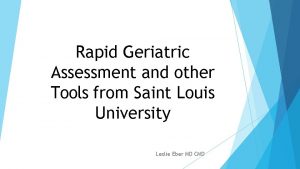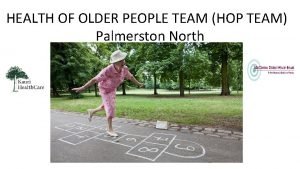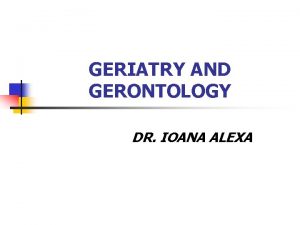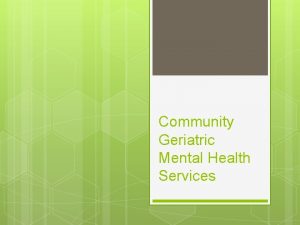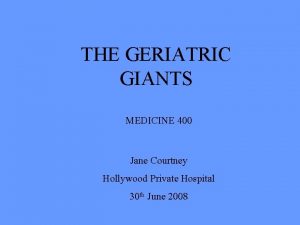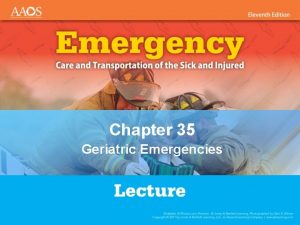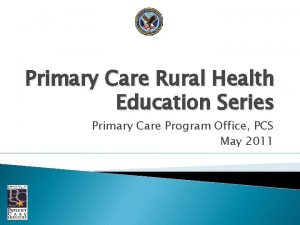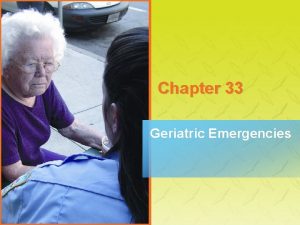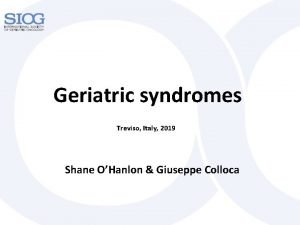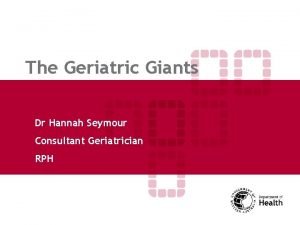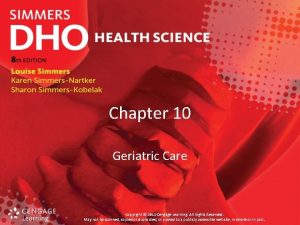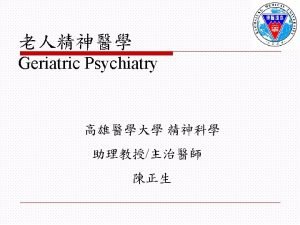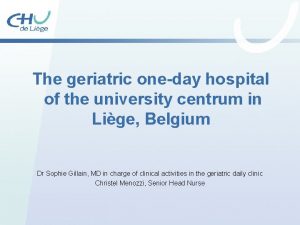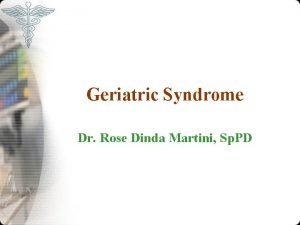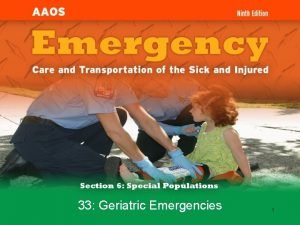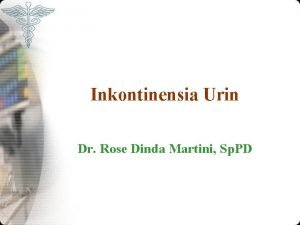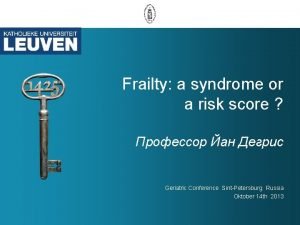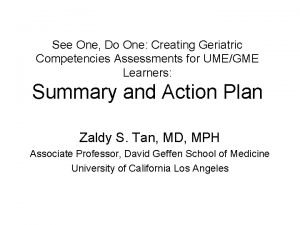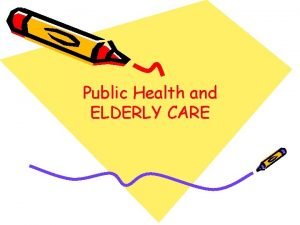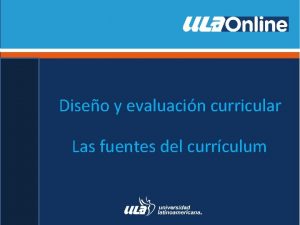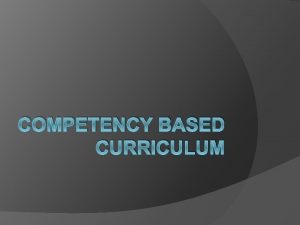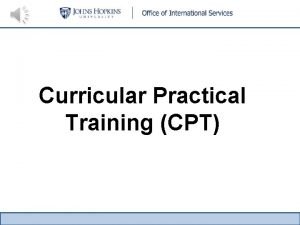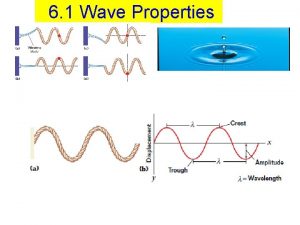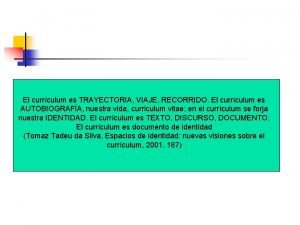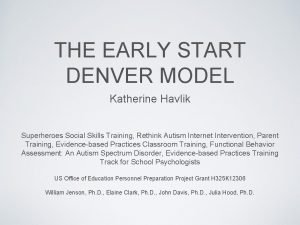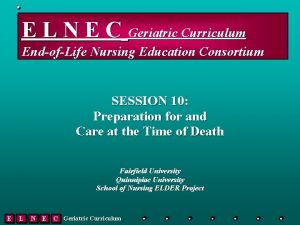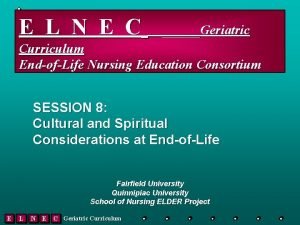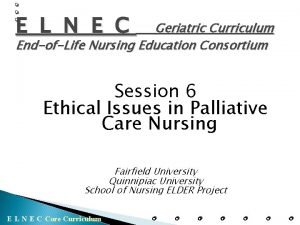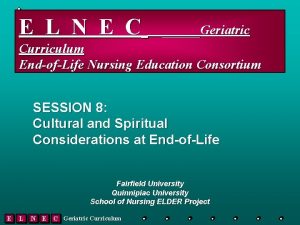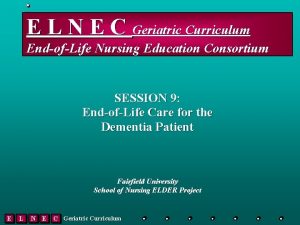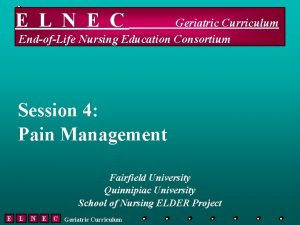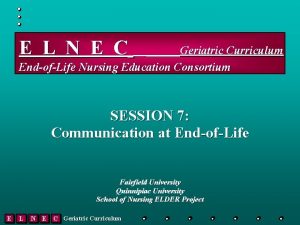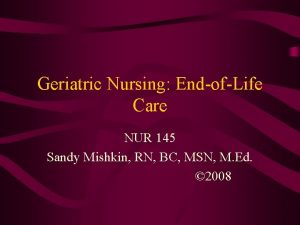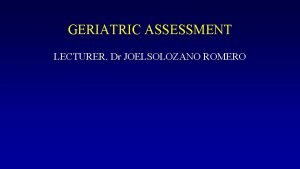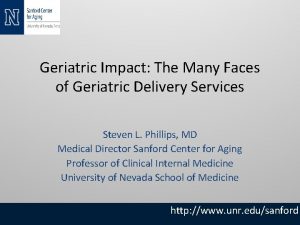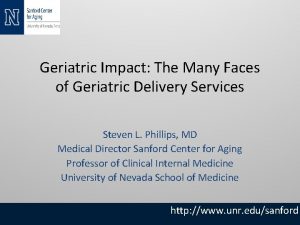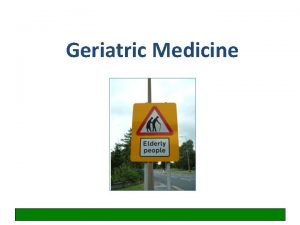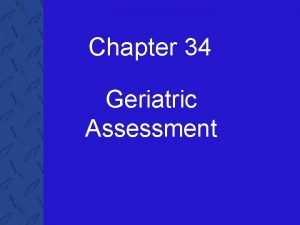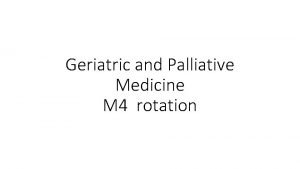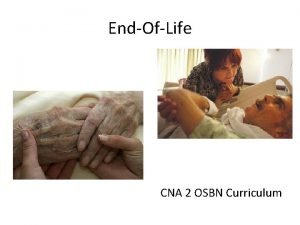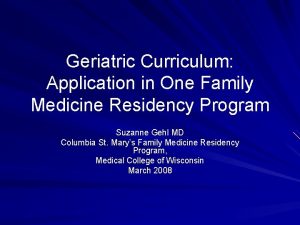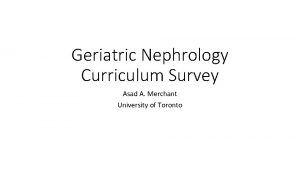E L N E C Geriatric Curriculum EndofLife



































- Slides: 35

E L N E C Geriatric Curriculum End-of-Life Nursing Education Consortium Module 1: Principles of Palliative Care Fairfield University Quinnipiac University School of Nursing ELDER Project “Supported by DHHS/HRSA/BHPR/Division of Nursing Grant#D 62 HP 06858”

Objectives: Upon completion of this session, the participant will be able to… • 1. Discuss the concept of “dying well” and how it applies to end-of-life (EOL) care. • 2. Compare and contrast the concepts of palliative care and hospice care. • 3. Describe the role of the health care team in providing quality palliative care for elder patients in various care settings. E L N E C Geriatric Curriculum

Group Activity…. What is your definition of “dying well”? E L N E C Geriatric Curriculum

“Dying Well” • A natural part of life • Opportunity for growth • Profoundly personal experience E L N E C Geriatric Curriculum

A “Good Death” Defined E • • • Be free of suffering Achieve life closure Receive care consistent with one’s beliefs, wishes and values L N E C Geriatric Curriculum

Concept of Suffering • State of severe distress • Threatens intactness of the person • Highly personal • Depth varies • Can lead to finding meaning Baird 2010; Ferrell & Coyle, 2008 E L N E C Geriatric Curriculum

Sources of Suffering • • • Fear of physical distress Perceptions of self Concerns regarding family relationships & social roles • Practical matters in a person’s life • Past experiences E L N E C Geriatric Curriculum

A client is dying. Which of the following statements indicates that the healthcare worker understands the concept of suffering? a. “Most people have many sources of suffering. ” b. “Suffering leads to finding a deeper meaning in life. ” c. “You will be able to determine what is causing your husband’s suffering. ” d. “Your husband’s suffering is related to the amount of pain he is in. ” E L N E C Geriatric Curriculum

Life Closure: A Personal Experience • Completion with worldly affairs • Completion of community relationships • Meaning about one’s individual life • Love of self • Love of others E L N E C Geriatric Curriculum

Life Closure: A Personal Experience (continued) • Completion of family/friend relationships • Acceptance of the finality of life • New self beyond personal loss • Meaning about life • Surrender to the unknown “Letting go” E L N E C Geriatric Curriculum

Dying Well – Goal of Hospice and Palliative Care Ensuring “good death” by addressing the needs of patients and their families and promoting a high quality of life E L N E C Geriatric Curriculum

Quality of Life Model • • Physical Well-Being Psychological Well-Being Social Well-Being Spiritual Well-Being http: //prc. coh. org E L N E C Geriatric Curriculum

Quality of Life Model Group Exercise… PHYSICAL PSYCOLOGICAL Quality of Life SOCIAL E L N E C Geriatric Curriculum SPIRITUAL

Physical Functional Ability Strength/Fatigue Sleep & Rest Nausea Appetite Constipation Pain Psychological Anxiety Depression Enjoyment/Leisure Pain Distress Happiness Fear Cognition/Attention Quality of Life Social Financial Burden Caregiver Burden Roles and Relationships Affection/Sexual Function Appearance Spiritual Hope Suffering Meaning of Pain Religiosity Transcendence http: //www. prc. coh. org 14

The agency is planning a discussion on the idea of healing. Which of the following statements should be included? a. Healing is a medical outcome and the discussion should be directed by doctors. b. Healing can occur only after the client’s spiritual issues have been resolved with a chaplain. c. Healing is possible if attention is paid to the many things that influence a person’s quality of life. d. Healing occurs when the patient and family accept that a cure is not possible. E L N E C Geriatric Curriculum

Early identification … • …means palliative care can start sooner, allowing the patient and the family to set and achieve goals and expand the concept of healing. E L N E C Geriatric Curriculum

The Goal of End-of-Life Care • Goal of EOL care is a “good death” • Addressing the multiple dimensions of quality of life helps ensure a “good death” E L N E C Geriatric Curriculum

All of the following behaviors improve the quality of end-of-life care Except a. limit client transfers when possible b. standardize protocols for dying patients and families c. promote continuity of care d. delay referral to hospice E L N E C Geriatric Curriculum

Cause of of Death/Demographic and Social Trends Administration on Aging, 2009; Arias et al. , 2003; Minino et al. , 2007 E L N E C Geriatric Curriculum

Nursing Homes are Ideal Sites to Implement Palliative Care • Approximately one-third of decedents aged 75 years and older died in skilled nursing facilities in 2001 www. cdc. gov. nchs/about/major/nnhsd/trendsnurse. htm • Palliative care principles have been integrated • Hospice providers provide: ü EOL pain & symptom management ü Psychosocial services ü Address EOL distress and suffering • Improve the quality of EOL care Hanson & Ersek, 2006; Carter & Chichin, 2003; Stevenson & Bramson, 2009 E L N E C Geriatric Curriculum

Hospice and Palliative Care • HOSPICE • PALLIATIVE CARE ü Most intense form of palliative care üLess than 6 months to live üAgrees to enroll in hospice program üChooses not to receive aggressive curative care üUnit of care: patient & family üPromotes idea of “living until you die” E L N E C Geriatric Curriculum üIdeally begins at the time of diagnosis üCan be used to complement aggressive treatments üEnhance quality of life üOptimize function üHelp with decision making üProvide opportunities for growth

Emergence of Palliative Care • Movement began in 1980 s, gaining momentum throughout the 1990 s • Goal: to move hospice care “upstream” • Hospices expanded services • Academic palliative care programs were instituted NCP, 2009; www. capc. org E L N E C Geriatric Curriculum

Palliative Care: Continuum of Care Death Disease-Modifying Treatment Hospice Care Palliative Care Bereavement Support Terminal Phase of Illness NCP, 2009; NQF, 2006 E L N E C Geriatric Curriculum

Palliative care… • can be given with life-prolonging treatment or as a main focus of care. • It is best provided by an interdisciplinary team which can more comprehensively identify the physical, psychological, social and spiritual burdens of illness. E L N E C Geriatric Curriculum

Which of the following comments shows a principle of palliative care? a. “We’re busy because most people prefer to die in a hospital rather than at home where they would be a burden. ” b. “Death and dying are not discussed much here in order to maintain hope for patients and families. ” c. “Because our patients often are uncomfortable, they need physical care more than psychological or spiritual care. ” d. “Patients are eligible for palliative care even though they are also receiving curative treatment. ” E L N E C Geriatric Curriculum

Interdisciplinary Care Team Exercise • What do you feel you contribute to the ICT by your professional knowledge and experience? • What do you feel you contribute to the ICT by your personal knowledge, experience and uniqueness? E L N E C Geriatric Curriculum

Hospice Medicare Benefit Eligibility Criteria: • Eligible for Medicare, part A • Terminal illness life expectancy of six months or less • Choose to receive hospice care rather than curative treatments • Enrolls in a Medicareapproved hospice program E L N E C Geriatric Curriculum

Hospice Includes: • Interdisciplinary team, often led by a nurse case manager • Physician services (although PCP generally directs medical care through hospice team) • Medical appliances and supplies • Drugs for symptom management and pain relief E L N E C Geriatric Curriculum

Hospice Services • • • Regular, scheduled visits 24/7 availability Coaches caregivers (family and staff in residential settings) • Short-term inpatient care for symptom management or respite care • Emotional and spiritual support • Bereavement services to survivors E L N E C Geriatric Curriculum

Hospice Today • Over 4850 hospice programs in the US • Average length of stay in hospice is 20 days • In 2008: 22% of hospice care was in nursing homes • 38. 5% of all deaths in the US were under the care of a hospice program • In 2008: 61. 7% of hospice admissions were non-cancer diagnosis. NHPCO, 2009 E L N E C Geriatric Curriculum

Hospice Benefits to Facility • CAN YOU IDENTIFY ANY BENEFITS HOSPICE CARE CAN BRING TO YOUR FACILITY? E L N E C Geriatric Curriculum

Hospice Benefits to Facility • Expertise in EOL care / symptom management • 24/7 consultation with hospice team • Decreases likelihood of disruptive transfers to hospitals • Provides in-service training to facility staff • Additional staff (home health aides) to assist with resident's personal care E L N E C Geriatric Curriculum

Experiences Caring for Dying Patients Think about the first time you cared for a patient who died. What was that experience like for you? E L N E C Geriatric Curriculum

CAN YOU RELATE? • “The sense of satisfaction to help someone makes me feel good about what I do. To me, the most important thing that a Nursing Assistant should do is just to be with the patient. The best thing is just to accept them and be with them, no matter what you happen to be doing. ” -Renee Meyer, CNA, CHPNA Source: Nursing Assistant Computerized Education Program E L N E C Geriatric Curriculum

References City of Hope & the American Association of Colleges of Nursing, 2007; Revised, 2010. The Endof-Life Nursing Education Consortium (ELNEC)Geriatric Training Program and Curriculum is a project of the City of Hope (Betty R. Ferrell, Ph. D, FAAN, Principal Investigator) in collaboration with the American Association of Colleges of Nursing (Pam Malloy, RN, MN, OCN, Co-Investigator). “Supported by DHHS/HRSA/BHPR/Division of Nursing Grant # D 62 HP 06858” E L N E C Geriatric Curriculum
 Sarc f
Sarc f Palmerston north geriatric
Palmerston north geriatric Geriatric giants mnemonic
Geriatric giants mnemonic Community geriatric psychiatry
Community geriatric psychiatry Geriatric giants
Geriatric giants Gems diamond geriatric
Gems diamond geriatric Va geriatric scholars program
Va geriatric scholars program Gems diamond geriatric
Gems diamond geriatric What is geriatric syndromes
What is geriatric syndromes Geriatric case presentation
Geriatric case presentation 4 geriatric giants
4 geriatric giants Chapter 10:4 confusion and disorientation in the elderly
Chapter 10:4 confusion and disorientation in the elderly Geriatric psychiatry definition
Geriatric psychiatry definition Centrum geriatric
Centrum geriatric Giant geriatric syndrome adalah
Giant geriatric syndrome adalah Geriatric nutrition
Geriatric nutrition Geriatric syndrome
Geriatric syndrome Gems diamond geriatric
Gems diamond geriatric Dr rose dinda martini
Dr rose dinda martini Geriatric hat trick
Geriatric hat trick Geriatric syndrome
Geriatric syndrome Geriatric competency assessment
Geriatric competency assessment Objectives of geriatric nursing
Objectives of geriatric nursing Fuentes del curriculum
Fuentes del curriculum Nys common core mathematics
Nys common core mathematics Cami maths online
Cami maths online Rationale of competency-based curriculum
Rationale of competency-based curriculum Guiding principles of ncf 2005
Guiding principles of ncf 2005 What is curriculum in education
What is curriculum in education Curriculum practice training
Curriculum practice training Sas curriculum pathways
Sas curriculum pathways Struktur curriculum vitae
Struktur curriculum vitae Curriculum niveau 3
Curriculum niveau 3 New eal curriculum victoria
New eal curriculum victoria Curriculum definicion
Curriculum definicion Early start denver model data sheet
Early start denver model data sheet
